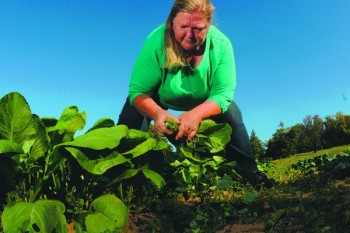
Beth Novak picks several varieties of Asian Greens at Mayfair Farm in Bunker Hill. With its flat land and moderate climate, the Eastern Panhandle is West Virginia’s most lucrative area for farming.
BUNKER HILL, W.Va. — Farming still is a tough business, according to Beth Nowak of Mayfair Farms in Bunker Hill.
Since 1983, Nowak and her husband have put in 14- to 16-hour days growing berries, apples, peaches, plums, apricots, pears and vegetables on their 60-acre land, selling their entire product at a Winchester farm market three days a week.
Nowak said farming in West Virginia is a difficult business to live off.
“The farmland in West Virginia isn’t too good,” Nowak said. “There’s a reason a lot of people moved from here to the West Coast. The first reason is rocks, the second is rocks and the third is rocks.”
However, despite the challenges, Nowak and her husband have lived off the land for three decades, putting their children through college. Nowak said one of the biggest challenges facing small farmers in the state is the regulatory climate.
“For example, in West Virginia, you can’t deal in raw milk, (and) if you want to do pickles, you have to go to a certified agency,” Nowak said. “In order for people like us, who make a profit of farming, the state needs to loosen up the regulations. At the farmers’ market down in Winchester, most of the big vendors there are from West Virginia. That should tell you something.”
PANHANDLE MAJOR ASSET TO STATE
According to the recently released West Virginia National Agricultural Statistics Services 2014 Annual Bulletin, the Mountain State ranks first in the nation for family farms and small farms.
The Mountain State also ranked ninth in the nation for apple production, 18th in chicken meat, 14th in peaches, ninth in trout and 18th in turkeys, generating sales of $750 million last year.
While corn fields and chicken coops can be found in all corners of the state, West Virginia Department of Agriculture Commissioner Walt Helmick said the Eastern Panhandle is a major asset in West Virginian agriculture.
“Morgan, Berkeley and Jefferson (counties) have the best situation in the state because of the quality land, quality atmospheric conditions and a good market,” Helmick said. “Jefferson County has the second amount of tillable land in the state, and those three counties not only have the West Virginia market to sell to, but also the 10 million or so people in Northern Virginia and Baltimore regions.”
While 52 percent of the state’s agriculture production is comprised of the poultry industry, centered in Hardy County, the three-county Panhandle is a leader in many crops.
Jefferson County is first in the state for corn production, growing 1.68 million bushels in 2013, while Berkeley is third in the state, producing 531,000 bushels. Jefferson and Berkeley also ranked as the top two counties for soybeans, with 442,000 and 70,700 bushels respectively. In terms of wheat, Jefferson ranked first in the state with 260,000 bushels, while Berkeley ranked second with 67,000 bushels.
Helmick said while production in the Panhandle is the best in the state, there is still much room for improvement.
“We as a state consume about $7.3 billion in food, but we only grow a three quarters of one billion, so we have a significant opportunity to increase production,” Helmick said. “There is a great interest in food being grown by West Virginians and for West Virginians.”
One of the main issues facing the state is the transportation cost of shipping food into the state. Helmick said he hopes to overcome that by introducing new crops into the state.
“Our most eaten product in this state is potatoes, and we import most of our potatoes from Idaho, which is done by rail, taking 8 days to travel over 2,400 miles,” Helmick said. “We need to starting growing more crops in this state so we can cut down on that cost.”
One of the major problems facing agriculture in the Eastern Panhandle is the encroachment of housing developments on farmland. Helmick said farmland protection is one way to keep farmers from selling their land.
“What we do is offer farmers a significant amount of money up front and then we rewrite their deed so the land, even if it transfers hands, remains farmland forever,” Helmick said. “We’ve seen an increase in farmland protection in the Eastern Panhandle and we hope to see more of it in the future.”
Helmick said the main challenge for increasing agricultural production in the Eastern Panhandle and the state as a whole is changing the perceptions about farming.
“Our biggest challenge is developing our workforce and changing the perception that agriculture is something you can’t make money at,” Helmick said. “The working conditions are good. It’s not the same as 50 or 100 years ago, because modern technology has greatly improved those hard chores that were connected to agriculture.”
SUCCESS COMES FROM SACRIFICE
Elsewhere in Berkeley County, the Orrs have proven in 60 years of business that agriculture can be highly profitable.
Growing on 1,100 acres and employing 195 people in packing, picking and running the farm market, Orr’s Farm Market produces many of the apples and peaches consumed in the area. According to Katy Orr-Dove, retail market manager, 85 percent of the product grown at Orr’s is sold wholesale to supermarkets, large farm markets, and baby food and juice suppliers. The rest is sold at the farm market.
Orr-Dove said while regulations change every year in the state, they are not as strict as states such as Maryland.
“Every year there’s additional regulations to follow, so you just have to stay abreast of it and make sure you implement it,” she said.
Orr-Dove said a lot of the obstacles the farm faces are like any farm. Weather and pests are major concern in growing produce. However, Orr-Dove said there are other challenges as well.
“Managing the employees is always a challenge,” Orr-Dove said. “We need to find good help for the right times, such as harvest.”
Orr-Dove said the key to the farm’s success is keeping it in the family.
“As farmers we don’t really want to say we’re a success because we don’t want to jinx ourselves,” Orr-Dove said. “However, the farm definitely has great potential for people to put hard work in and sacrifice to support the family and the broader community.”
Orr-Dove said family members put in about 50 to 70 hours a week, leading to a lot of sacrifices to keep the farm going.
“Everybody has to be on the same page and everybody has to work toward the same goals,” Orr-Dove said. “When harvest comes in, everybody has to pitch in and help out.”
And as for Nowak, she said if she had it all to do over again, she would still farm.
“It’s not just that you don’t have to work with people or call your own shots, it’s a way of life,” Nowak said. “You get out of it exactly what you put into it.”






